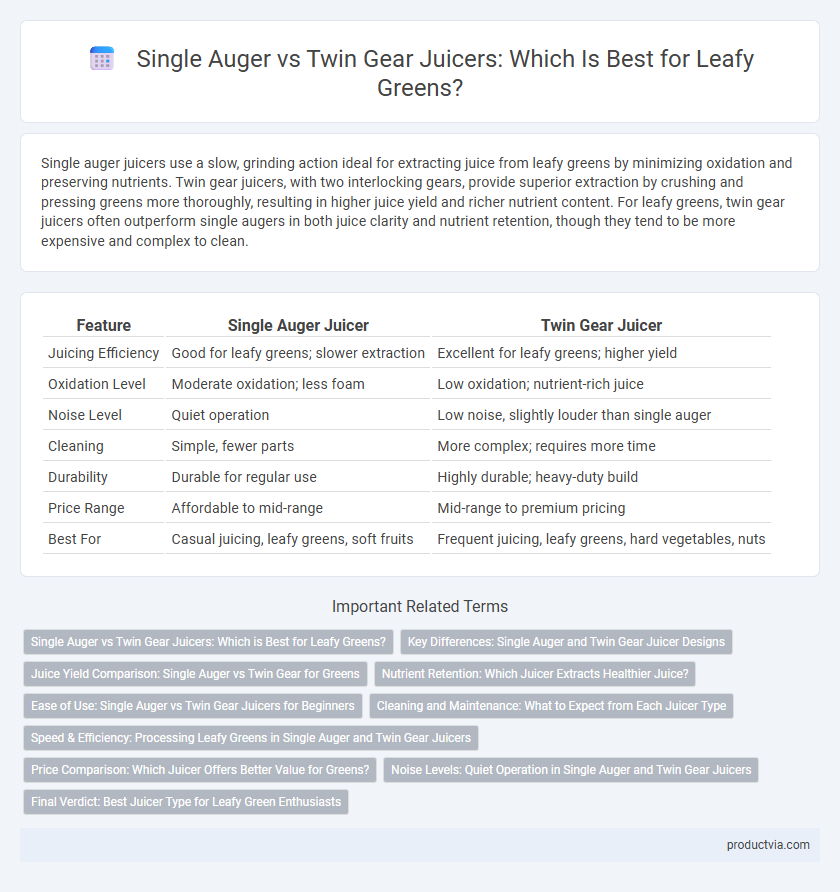Single auger juicers use a slow, grinding action ideal for extracting juice from leafy greens by minimizing oxidation and preserving nutrients. Twin gear juicers, with two interlocking gears, provide superior extraction by crushing and pressing greens more thoroughly, resulting in higher juice yield and richer nutrient content. For leafy greens, twin gear juicers often outperform single augers in both juice clarity and nutrient retention, though they tend to be more expensive and complex to clean.
Table of Comparison
| Feature | Single Auger Juicer | Twin Gear Juicer |
|---|---|---|
| Juicing Efficiency | Good for leafy greens; slower extraction | Excellent for leafy greens; higher yield |
| Oxidation Level | Moderate oxidation; less foam | Low oxidation; nutrient-rich juice |
| Noise Level | Quiet operation | Low noise, slightly louder than single auger |
| Cleaning | Simple, fewer parts | More complex; requires more time |
| Durability | Durable for regular use | Highly durable; heavy-duty build |
| Price Range | Affordable to mid-range | Mid-range to premium pricing |
| Best For | Casual juicing, leafy greens, soft fruits | Frequent juicing, leafy greens, hard vegetables, nuts |
Single Auger vs Twin Gear Juicers: Which is Best for Leafy Greens?
Single auger juicers use a slow, single screw to crush leafy greens, minimizing oxidation and preserving nutrients, while twin gear juicers employ dual gears for more efficient grinding and higher juice yield from fibrous greens. Twin gear juicers typically offer superior extraction and nutrient retention due to their dual pressing action, making them ideal for tough leafy greens like kale and spinach. Single auger models are often quieter and easier to clean but may produce slightly less juice and pulp consistency compared to twin gear counterparts.
Key Differences: Single Auger and Twin Gear Juicer Designs
Single auger juicers use one spiral gear to crush and press leafy greens, offering slower processing speeds with moderate juice yield and easy cleanup. Twin gear juicers feature two interlocking gears that chew and crush greens more thoroughly, maximizing nutrient extraction and juice output while maintaining higher efficiency. The dual-gear design also minimizes oxidation, preserving vitamins and enzymes better than single auger models.
Juice Yield Comparison: Single Auger vs Twin Gear for Greens
Twin gear juicers consistently produce higher juice yields from leafy greens compared to single auger models due to their dual gear mechanism that efficiently crushes and presses greens to extract more liquid. Single auger juicers operate at slower speeds but may leave more moisture in the pulp, resulting in lower juice output. For maximizing juice yield from leafy greens, twin gear juicers are generally preferred because they optimize fiber breakdown and liquid extraction.
Nutrient Retention: Which Juicer Extracts Healthier Juice?
Single auger juicers operate at slower speeds, minimizing heat and oxidation to preserve more nutrients in leafy greens. Twin gear juicers, with their dual crushing mechanisms, more effectively break down fibrous greens, releasing higher concentrations of vitamins, minerals, and enzymes. For optimal nutrient retention in leafy greens, twin gear juicers generally produce healthier juice, although single auger models offer a balance of efficiency and nutrient preservation.
Ease of Use: Single Auger vs Twin Gear Juicers for Beginners
Single auger juicers offer straightforward operation with fewer parts to assemble and clean, making them ideal for beginners processing leafy greens. Twin gear juicers require more assembly and maintenance but provide higher juice yield and nutrient retention, appealing to users willing to invest time in setup. Ease of use favors single auger models for quick, simple juicing, especially for those new to juicing leafy greens.
Cleaning and Maintenance: What to Expect from Each Juicer Type
Single auger juicers typically feature simpler parts, making cleaning faster and maintenance easier, which is ideal for leafy greens that can clog more complex mechanisms. Twin gear juicers have intricate components designed for extracting maximum nutrients but require thorough cleaning to prevent residue build-up from fibrous greens, demanding more time and effort. Choosing between them depends on balancing ease of use with nutrient extraction efficiency when processing leafy vegetables.
Speed & Efficiency: Processing Leafy Greens in Single Auger and Twin Gear Juicers
Single auger juicers operate at slower speeds, typically around 40-80 RPM, which minimizes oxidation and preserves nutrient integrity in leafy greens. Twin gear juicers, with dual augers running at similar or slightly higher speeds, apply powerful crushing and grinding action to extract maximum juice yield from fibrous leafy vegetables efficiently. The slower processing in both juicer types enhances nutrient retention, but twin gear models often deliver superior pulp dryness and juice clarity for leafy greens.
Price Comparison: Which Juicer Offers Better Value for Greens?
Single auger juicers typically cost less upfront than twin gear juicers, making them a more affordable option for juicing leafy greens. Twin gear juicers deliver higher juice yield and nutrient retention but come with a significantly higher price tag, often double or more than single auger models. For budget-conscious buyers prioritizing value, single auger juicers balance cost-effectiveness with decent performance on greens, while twin gear juicers offer premium efficiency at a premium price.
Noise Levels: Quiet Operation in Single Auger and Twin Gear Juicers
Single auger juicers operate with lower noise levels, making them ideal for quiet environments and early morning use. Twin gear juicers produce louder sounds due to their dual meshing gears, but they offer higher nutrient extraction. Noise-sensitive users often prefer single auger models for their quiet operation during juicing leafy greens.
Final Verdict: Best Juicer Type for Leafy Green Enthusiasts
Twin gear juicers excel at extracting maximum nutrients and juice yield from leafy greens due to their slow, cold-press mechanism that preserves enzymes and minimizes oxidation. Single auger juicers offer efficiency and ease of use but may produce slightly lower juice quality and quantity when processing fibrous greens. For leafy green enthusiasts prioritizing nutrient retention and juice purity, twin gear juicers represent the best investment despite their higher price and maintenance requirements.
Single auger vs Twin gear for leafy greens Infographic

 productvia.com
productvia.com